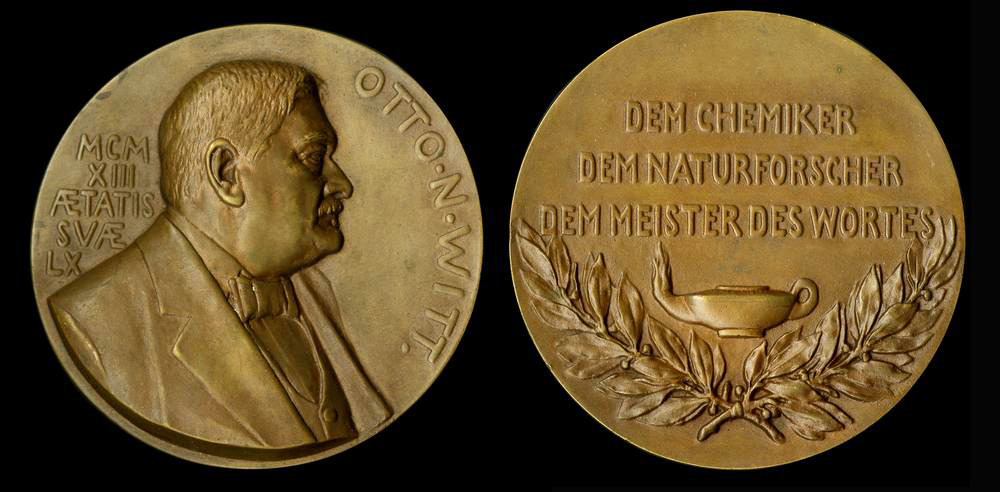Otto Nikolaus Witt, 1853 - 1915
by Brian Stevenson
last updated September, 2021
Otto N. Witt was a well-regarded amateur diatomist, most active during the 1870s and 1880s. He gave names to several species of diatomaceae. In 1888, he published an authoritative book on the diatoms and polycistina of Haiti.
Witt was also an expert mounter of diatoms (Figures 1 and 2). He offered his selected and arranged diatom slides in exchange for raw material (Figure 3).
Professionally, Witt was a chemist, specializing in development of dyes. He worked in Germany and England. In 1891, he became a Professor of chemical technology at the Techniches Hochschule Charlottenburg (now Technische Universität Berlin). In addition, he founded and edited Prometheus, a general science journal in the vein of Nature.

Figure 1.
Microscope slide of arranged diatoms, prepared by Otto N. Witt in 1879. The mount consists of Aulacodiscus kittonii from San Francisco and Campylodiscus clypeus from Franzensbrun (Eger). The inclusion of two unrelated diatoms from two distinct locations suggests that Witt prepared this slide for exchange/sale, rather than for a scientific use.

Figure 2.
Arrangement of an Aulacodiscus kittonii (center) surrounded by ten Campylodiscus clypeus diatoms, prepared in 1879 by Otto Witt. Photographed with a 10x objective lens and C-mounted digital SLR camera.

Figure 3.
1884 offer from Otto Witt to exchange "first-class slides of rare diatoms (arranged)" for raw diatomaceous material, from "Hardwicke's Science-Gossip". The microscope shown in Figures 1 and 2 was probably prepared by Witt for such an exchange.

Figure 4.
Otto N. Witt, ca. 1905.
Otto Nikolaus Witt was born on March 31, 1853, in St. Petersburg, Russia. His father, a native of Holstein (Germany), was professor of general and applied chemistry at the Superior Technical School. In 1864, the Witt family moved to Munich. They settled in Zurich in 1866, and became naturalized Swiss citizens.
Witt developed into a skilled microscopist and diatom expert during his teenage years. He was barely twenty years old when he published two descriptive papers on diatoms of the South Seas (western Pacific Ocean below the equator). Each of those 1873 papers was accompanied with a plate of illustrations by Witt (Figure 5).
During the autumn of 1873, Witt took a position as an analytical chemist at an iron works in Duisburg, Germany.
Witt returned to Zurich in early 1874, working in a printing business. Here, he learned about the use of natural and artificial substances for dyeing and printing. He extended his education by completing a Ph.D. on that topic in July, 1875.
Later in 1875, Witt moved to England, taking work as a chemist in the dye-making business of Williams, Thomas and Dower, at Brentford, near London. In January, 1876, he developed chrysoidine, a bright orange pigment, and a series of acid azo-colors that were marketed under the name of "tropaeolines". Chrysoidine and the tropaeolines became important industrial dyes.
Witt left England in late 1879, successively working for dye manufacturers in Frankfort-on-the-Main and Mulhouse. The microscope slide of arranged diatoms that is shown in Figures 1 and 2 was produced when Witt lived in either England or Frankfurt.
In 1882, he became director of the Association of Chemical Factories (Verein Chemischer Fabriken) in Waldhof, near Mannheim. The 1884 exchange offer shown in Figure 3 dates from Witt's time in Mannheim.
Witt left industry for academia in 1885, joining the Techniches Hochschule in Charlottenburg (near Berlin). At that time, he became a German citizen. He was promoted to professor of chemical technology in 1891.
Throughout this time, Witt remained an enthusiastic diatomist. An 1885 paper on preparing diatoms was translated and printed in The Journal of the Royal Microscopical Society as "Removal of siliceous coverings from fossil diatoms". Witt co-authored a book on the diatoms and polycistina of Jeremie, Haiti in 1888 (Figure 6).
In 1890, Witt founded Prometheus, a German-language journal intended to disseminate a broad range of scientific knowledge, in the vein of the English-language Nature (Figure 7). Witt also served for many years as editor of Die Chemische Industrie (Figure 8).
Otto Witt died of heart disease in Charlottenburg on March 22, 1915. The significance of his contributions to chemistry is evident from The Journal of the Chemical Society including a lengthy obituary for this German among those of numerous Chemical Society members who had recently died in the Great War against Germany.

Figure 5.
Illustrations of diatoms by Otto Witt, from his 1873 publications.

Figure 6.
Title page of Truan y Luard and Witt's 1888 book on the diatoms and polycistina of Jeremie, Haiti.

Figure 7.
Title page of an 1893 edition of Witt's journal, "Prometheus".

Figure 8.
Title page from a 1906 edition of "Der Chemische Industrie", edited by Otto Witt.

Figure 9.
A 1913 medal that was struck in honor of Otto Witt. Adapted for nonprofit, educational purposes from https://www.britishmuseum.org/collection/object/C_1929-0408-3 .
Resources
Hardwicke's Science-Gossip (1884) Exchange offer from Otto N. Witt, Vol. 20, page 192
Journal of the Chemical Society (1876) Minutes of the June 15 meeting, page 687
Journal of the Chemical Society (1915) Obituary of Otto Nikolaus Witt, Vol. 109, pages 428-431
Journal of the Royal Microscopical Society (1886) Removal of siliceous coverings from fossil diatoms, pages 880-881
Truan y Luard, A, and O.N. Witt (1888) Die Diatomaceen der Polycystinenkreide von Jérémie in Hayti, Westindien, Friedlander und Sohn, Berlin
Witt, Otto N. (1873) Bericht uber die Untersuchung zweier Diatomaceen-Gemische. Ein Beitrag zur Kenntniss der Flora der Sudsee, Journal des Museums Godeffroy, Vol. 1, pages 63-70
Witt, Otto N. (1873) Ueber Sudsee-Diatomacean, Journal des Museums Godeffroy, Vol. 1, pages 287-292








